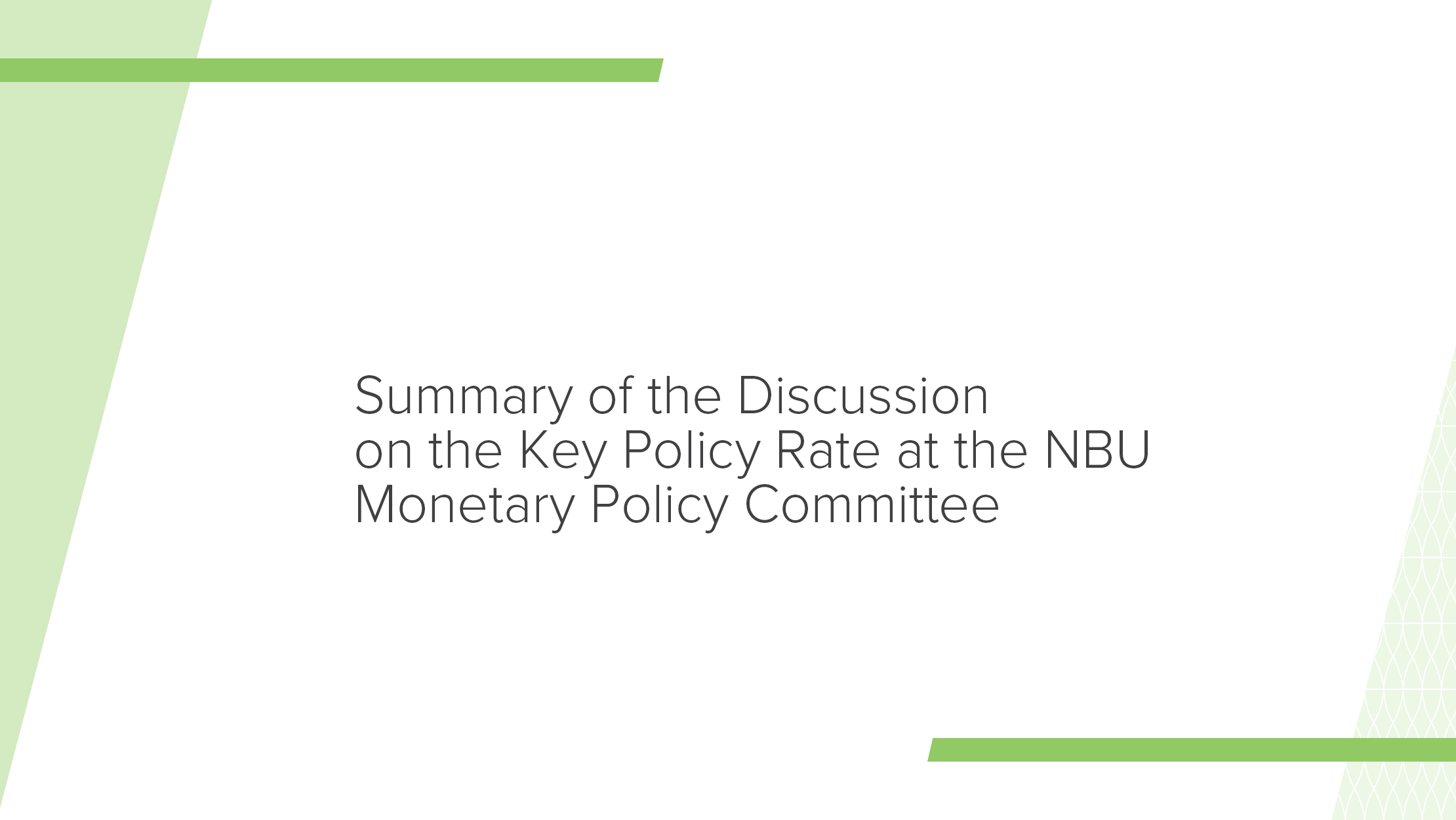Date of the meeting: 20 January 2021.
Attendees: all ten members of the Monetary Policy Committee (MPC) of the National Bank of Ukraine:
- Kyrylo Shevchenko, Governor of the National Bank of Ukraine
- Kateryna Rozhkova, First Deputy Governor
- Yuriy Heletiy, Deputy Governor
- Yaroslav Matuzka, Deputy Governor
- Dmytro Sologub, Deputy Governor
- Oleksii Shaban, Deputy Governor
- Vitalii Vavryshchuk, Director of the Financial Stability Department
- Volodymyr Lepushynskyi, Director of the Monetary Policy and Economic Analysis Department
- Oleksii Lupin, Director of the Open Market Operations Department
- Yuriy Polovniov, Director of the Statistics and Reporting Department.
During the meeting, the MPC members paid special attention to discussing elevated inflationary pressures in late 2020 through early 2021.
Inflation accelerated at the end of the year and reached the midpoint of the 5% ± 1 pp target range, the discussants pointed out. However, the momentum that is driving the increase in inflation and pulling it away from the target will persist in H1 2021. In particular, inflation is expected to breach the upper limit of the target range already in January this year.
On the one hand, the main factors accelerating inflation are mostly temporary and largely beyond the effective influence of monetary policy. Were the key policy rate to change in January, it would not offset the effects of last year’s poor harvest, pass-through of a weaker hryvnia, higher energy prices, and increases in certain tariffs. The impact of these factors will mostly fade in H2 2021, with or without a monetary policy response.
Meanwhile, fundamental inflationary pressures have been mounting. Real household incomes continue to grow, driven by more social spending and higher wages, including the minimum wage. Complicated border-crossing rules limit international tourism, enticing the public to spend more money within the country. In addition, remittances from abroad continue to be high. Judging by strong retail performance, the pandemic is not putting much of a drag on the surge in consumer demand.
In December 2020, most respondents also reported worsened inflation expectations. Households are usually guided by emotion as they adapt their expectations to current conditions, meaning that this spike in expectations could be only temporary. More specifically, the negative reaction may be due to higher prices for consumer goods and higher utility bills. At the same time, imbalances in expectations increase the risk that inflationary pressures may rise further, which means that special attention should go to monitoring business and consumer sentiment, all MPC members agreed.
The speedy recovery in the global economy and massive stimulus programs in developed countries are keeping prices high in commodity markets. Inflationary pressures from Ukraine’s major trading partners also are growing as business activity and depreciation effects in some of these countries intensify. However, investor optimism amid overly loose monetary conditions and the start of a global push to vaccinate against the coronavirus has already led to significant capital inflows into EMs. Portfolio investment inflows into Ukraine also have resumed. This creates conditions that may ease inflationary pressures through the exchange rate channel.
Ukraine’s economy also is recovering faster than anticipated. Aggregate demand, external demand in particular, is growing. Loose fiscal and monetary policies have helped the economy recoup from the crisis. The NBU has improved its forecast for GDP decline in 2020 to 4.4% from 6%. The economy this year is expected to regain almost all of the ground it has lost to the coronavirus crisis. At the same time, business sentiment remains downbeat, in part due to the January lockdown.
Eight of the ten MPC members offered to leave the key policy rate unchanged at 6%, but voiced different risk assessments regarding inflation developments.
Most MPC members agreed that inflationary pressures would continue to rise and would require a response from the NBU in the near future. However, January would be too soon to raise the key policy rate. One should keep in mind that the factors behind the current acceleration in inflation are mainly temporary and largely insensitive to changes in the key policy rate, meaning that after picking up in the coming months, inflationary pressures could ease at a later time on the policy horizon.
Risks to the baseline inflation forecast at this point are balanced, one MPC member said. Market interest rate movements are showing no signs that expectations have worsened markedly. Interest rates on most bank deposits and loans have been declining over the past month, as have rates on hryvnia domestic government debt securities in the primary and secondary markets. Holding the key policy rate flat meets market expectations and will signal support of economic growth.
This decision will have a positive impact on the credit market, which the NBU seeks to revitalize as one of its priorities, another MPC member said. Businesses, still pessimistic about their development prospects and inclined to lay off workers rather than expand, are looking for these signals. In addition, raising the key policy rate could depress business sentiment in the wake of the January lockdown.
Going forward, inflationary pressures will ease, several discussants pointed out. This means that an unexpected rate hike in these conditions may be unnecessary, whereas an anticipated decision will calm the market, they said.
What is more, the 2019 scenario where foreign capital flooded the Ukrainian economy is likely to repeat itself, one MPC member said. If it does, the hryvnia will strengthen, and pressure on consumer prices will ease. In late 2020 through early 2021, foreign investors already regained interest in Ukraine’s government securities, and this trend may continue throughout the year, given the loose monetary conditions around the globe.
The NBU is faced with a very complicated choice between keeping the key policy rate unchanged and raising it, two MPC members said. Inflation is projected to breach the target range as soon as January this year. With the economy recovering, demand surging, and risk of new lockdowns waning as governments worldwide push for immunization, it no longer makes any sense to expect the pandemic to have disinflationary effects. The uncertainty factor is also losing relevance, as citizens and businesses have learned to operate under quarantine restrictions. Probable capital inflows also should be estimated conservatively. According to these MPC members, there will not be a repeat of the 2019 scenario, because investors today have more cautious assessments of Ukraine’s development even as the world is being flooded with cash. In particular, recent auctions by the Ministry of Finance suggest that nonresidents are not ready to invest in long-term domestic government debt securities, and that the delay in the IMF program may further deter them from ramping up investments in Ukraine. In contrast, if the government bets on sales of short-term domestic government debt securities, the debt burden may peak again in 2021–2022, putting public finances under more pressure to repay. Thus, the prerequisites for a proactive rate hike are already in place.
However, there are several arguments that make the case for holding the key policy rate flat, these MPC members said. First, the impact of pro-inflationary factors that are beyond the scope of monetary policy is still decisive, and is also mostly short-term. Meantime, movements in core inflation, which is much quicker to respond to key policy rate changes, have been more restrained. Second, keeping the key policy rate unchanged will underpin economic recovery in the aftermath of the January lockdown. Third, the difference in scenarios between keeping the key policy rate unchanged and raising it marginally is about to stop being that noticeable. Meanwhile, expert surveys have shown that leaving the rate where it stands is the best and most likely option, implying that this decision will not have an adverse impact on expectations. The rate increase can thus be postponed until March, when we have a clearer picture of the pandemic, IMF cooperation, and foreign capital inflows.
Two MPC members advocated raising the key policy rate to 6.5%.
These discussants pointed to much stronger inflationary pressures than projected in the October macroeconomic forecast. They also agreed that because a key policy rate hike was inevitable, it was necessary to increase the rate now.
A rate raise has been long in coming and must be communicated to the market before it is too late, one of these MPC members emphasized. This proactive stance will come as a clear signal that the NBU is committed to ensure that prices remain stable. In contrast, delaying the rate hike will only add to uncertainty and erode the market’s confidence in the consistency of the NBU’s monetary policy. In addition, there is no longer any doubt that the recovery in consumer demand is sustainable: real incomes have been growing, as have underlying inflationary pressures from demand.
Another MPC member in favor of raising the key policy rate drew attention to external factors. Funds allocated under additional large-scale economic stimulus programs in developed countries will eventually end up in commodity and stock markets and increase external inflationary pressures, this MPC member said. Domestic inflation expectations have already worsened, this MPC member pointed out. Thus, given the projected acceleration in inflation above the target range in the months ahead, the NBU must respond by raising the key policy rate now. Doing it later may be perceived as a late policy response.
The MPC members also were divided over the projected trajectory of the key policy rate, although most of them believe that an increase in the key policy rate in 2021 is inevitable.
Over the next few months, the key policy rate needs to be raised moderately, to 6.5%–7%, most MPC members suggested. This should help ease underlying inflationary pressures and improve inflation expectations, thus gradually slowing inflation and returning it to the 5% ± 1 pp target range in early 2022.
That said, several MPC members believe that an increase in the key policy rate will not be necessary, given that the pro-inflationary factors are temporary and that there are likely to be offsetting factors, including foreign capital inflows. The latter will be sufficiently powerful and will actually enable the NBU to slightly cut the key policy rate to a new all-time low, one of these MPC members said.
The decision to set the key policy rate at 6.0% per annum was approved by the NBU Board at the monetary policy meeting held on 21 January 2021.
The Monetary Policy Committee (MPC) is an NBU advisory body that was created to share information and opinions on monetary policy formulation and implementation, in order to deliver price stability. The MPC comprises the NBU Governor, NBU Board members, and directors of the Monetary Policy and Economic Analysis, Open Market Operations, Financial Stability, and Statistics and Reporting Departments. The MPC meets the day before the NBU Board meeting on monetary policy issues. Decisions on monetary policy issues are made by the NBU Board.


